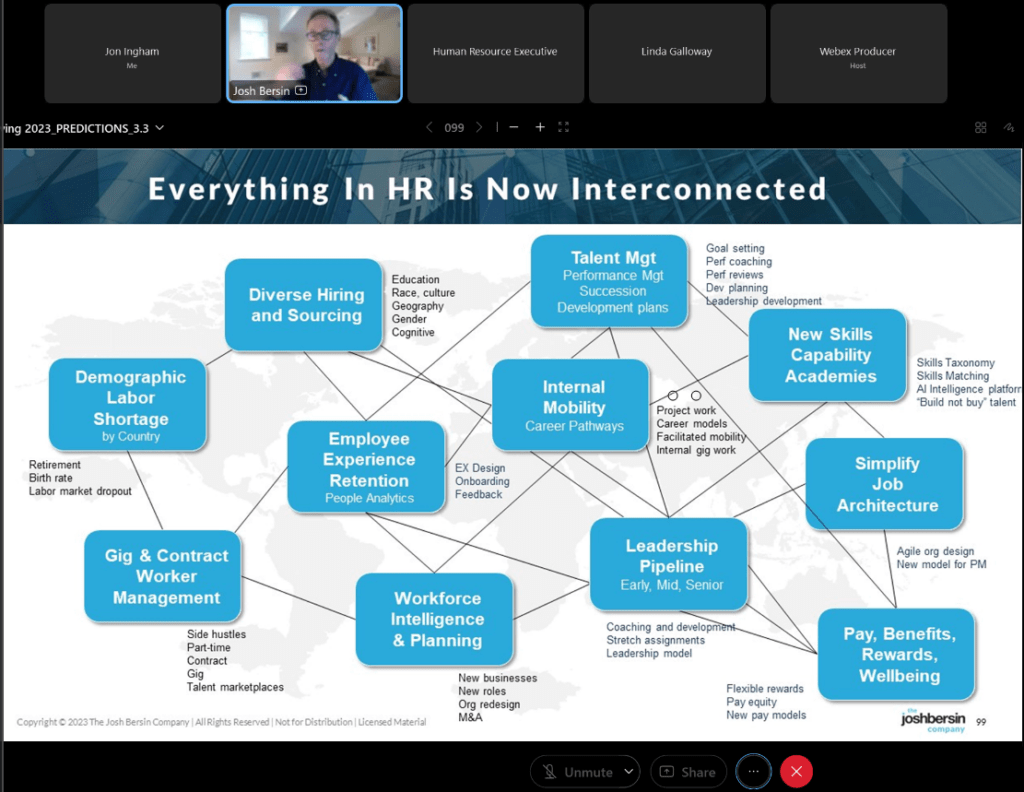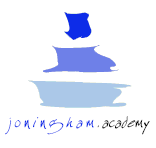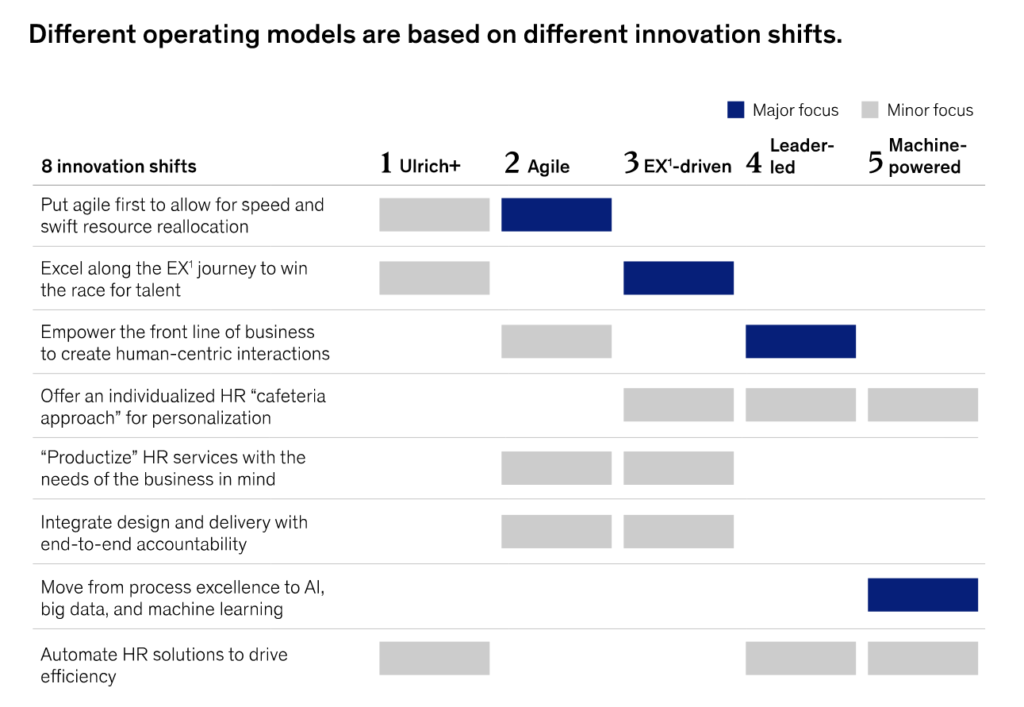Josh Bersin Systemic HR Operating Systems

HR transformation seems to be a particularly topical agenda at the moment, and I’ve also just written about the use of paradox to choose an appropriate HR organisation form.
I’ve also previously posted on McKinsey’s recent review of what they see as the main operating models HR should consider beyond the standard Ulrich model (the familiar three legged stool of HRBPs, COEs and service centres) which includes Ulrich plus, Agile, EX, leader led, and machine powered.
Since then, attention has moved on to Josh Bersin’s suggestions about Systemic HR, and in the spirit of helping HR leaders and groups think through all these new opportunities, I add my notes on this model (or system!) too. Apologies that these are rather long, but they detail the analysis I’ve been through in order to understand for myself what (I think) Josh is suggesting.
My most substantive comments come lower down this post, and you may want to scroll straight down to these, but I do also want to deal with some of Josh’s broader comments about existing models and what organisations generally do now in what I see as slightly pejorative terms. Because I don’t believe HR has often been designed just around service delivery efficiency. And HR’s operating model should have never fully presribed ‘who does what’. HRBPs should have always operated as lead consultants to the business. Good HR leaders have always “focused on business alignment, systems thinking, transformation, and external benchmarks” (actually, I think we already focus too much on benchmarks). And HR should always have been measured as “drivers of reinvention, transformation, reskilling, agility, productivity, and business growth”. Etc.
I personally wish people wouldn’t make these sorts of exaggerations – it drives attention but doesn’t help move the profession forward. And in this case at least, it’s just not needed. There are some real and important details in Josh’s analysis (as I’d expect from him), once you’ve got through his less useful suggestions about systemic operating systems!
.
Systemic?
Josh suggests we need to look at organisational changes and people strategies in an integrated, systemic way, ensuring HR is totally interconnected. That’s absolutely critical, but really isn’t that new, as both good organisation design and good HR has long been integrated. For example, I wrote a chapter for ‘the Executive Guide to Integrated Talent Management’ back in 2011.
And actually, this integration is the whole point of Dave Ulrich’s HR model dating back at least as far as 1997. Paraphrasing Dave, HR acts as a business partner when all constituent parts act together to deliver in all of our necessary roles. And so HRPBs, COEs, Service Delivery and any other teams have always needed to act as an ‘integrated operating system’ in order for HR as a whole to partner effectively with the business it works within.
.
An integrated Operating System?
Josh suggests we need an operating system, not an operating model because “the key to a fast-moving organization is not to set rules and create operating standards. It’s a problem of creating a set of shared culture, values, and priorities. It’s also about assigning accountability, developing relationships between people, and motivating people to help each other solve problems.”
All of that is true, but once again, has always been true, and applies to all types of organisation. So even if you compare the differences between an exaggerated traditional, functional, bureaucratic organisation focused on rules and standards, and an extreme example of a modern, self managing organisation “without focus on job title, job level, or politics”, you’re still only looking at one operating model vs another, or one operating system vs another. Some models / systems may be more systemically integrated than others, but we can talk about models or we can talk about systems – they are not qualitatively different things.
Also “the organisation structure you draw on a whiteboard” has never been the central part of any effective organisation design. The benefits of any operating or organisation model or system have always been systemic, resulting from all the interconnected elements of the model.
.
Benefits?
Josh suggests that his systemic approach could avoid experiences like the over-hiring in tech companies we have seen recently, leading to the layoffs we have seen this year. “Maybe we could have pushed back a little and prevented some of this overshooting?”
Well, maybe. But I don’t believe Talent Acquisition functions were that isolated (we can always do better), and even if they were ‘taking orders’, that’s about business leaders getting their growth projections wrong (understandably, given that businesses have never before experienced a standing start such as that leading on from the pandemic). But business leaders are responsible for managing their business areas, HR is responsible for ensuring they can do that, ie that they have the people they need – including by informing decisions on who they need and how the recruitment is done. And yes, we should have discussed the risks involved, and the cost and pain involved in a resizing should that be needed, but it’s not our job to second guess or constrain business decisions (other than by being part of a broader leadership team). And anyway, HR being even more integrated wouldn’t have helped with any of this. Better talent intelligence might have – and I do support Josh’s call for better “AI and analytics in real-time, including insights on skills, labor market, and workforce” as part of a systemic approach.
But what really hit tech companies was that they’d not effectively navigated the polarities of current and future state based planning. These firms probably did look too for into the future, and not enough at the present, “steadily building better sales and go to market teams, re-engineering along the way”. But then Josh extols Ford for splitting off its EV business, which is a great example of future state based planning. So again, the real need is to straddle the polarities, not necessarily to use either a current state or future state based approach.
.
OK, but what is the model?
Josh is still researching this model (or system), and so it’s not clearly scoped out. But he does explain that “HR, in its traditional form, was not designed this way (ie systemically). We mostly adopted a 1980s HR Service Delivery Model designed to minimize cost and cluster specialists into separate groups. (The Recruitment Team, the Training and Development Team, the Compensation and Benefits Team, and so on.) It’s time to stitch this all together: HR should systemically focus on problems not programs.”
Josh is right that organisations have changed, are changing, and that HR needs to change as well. But, because I think that HR is already stitched together quite well, I suggest the real need is actually for restitching, ie stitching together in a different way. And Josh does describe a number of different HR groups within a systemic HR model, mainly operating cross-functionally or horizontally across a business, so I think what he’s really describing is unstitching the traditional three legged stool, and stitching up something rather different Or actually, since HR also needs to be more agile, perhaps we should now just be using velcro!
(I’d also challenge whether problems – or even talent intelligence – are always the right focus for HR work, as these will tend to tilt us too far towards current vs future state again. Yes, we need to respond to short-term issues, and also opportunities, but always with a view towards what we’re trying to create longer-term as well.)
.
Horizontally focused HR groups?
Josh’s main suggestion is for more horizontally vs vertically focused groups (that’s what I call them) which I think needs to go beyond meaning that “we have a set of agreed-upon projects and priorities and we operate with purpose, clarity, and peer feedback”. After all, Dave Ulrich added project teams to his model and has been talking about HR becoming more like a professional services firm for at least 15 years too. And this is one of my favourite articles on horizontal HR working and dates back to 2015.
Josh asks, “The real problems we face in HR are all systemic. They cannot be solved by one HR domain alone. Why then do we organize our HR organizations into Centers of Expertise (COE) and specialties?”
The answer is because problems increasingly need deep knowledge as well as a broad perspective. We do need specialists. (Josh seems to agree as he notes that we already have COEs in analytics and employee experience in addition to traditional areas such as recruiting and training and that today, these are being extended to talent intelligence too).
So, as I described in ‘The Social Organization’, the way we respond to complex, systemic issues is not necessarily to increase the proportion of generalists in a model, but to bring people from different vertical, functional specialisms together into horizontal teams, focused on customers (potentially, employees) or particular business objectives.
Josh refers to these horizontal groups which he suggest mean we can operate without COEs as ‘solution centres’, ‘pods’, “or other structures that organise HR teams into various workforce segments, functional groups (outside HR), or problem areas – bringing HR disciplines together to address issues.” He provides an example of a retail operations academy at Bank of America.
Solution centres operate cross-functionally across HR, so that instead of having one plan and one set of outcomes but acting independently (“HR domains acting as interconnected silos”), we’d work more together too (“HR domains work as an integrated whole, sharing insights and working on cross-functional problems.”)
I also think solution centres would manage their own delivery, so these groups would be a bit like the way some HR teams already integrate their COEs with their service centres in order to reduce what can be a tendency to design processes for theoretical excellence rather than practical implementability.
This new focus on workforce segments is a good idea, and I’d suggest the main newish insight in the model. However, it’s not really that new, as many organisations have run business partner teams rather than independent business partners in at least some business groups in order to provide more solution capability within these areas. Also, I was an HRD back in the 1990s and we created a ‘trainee development group’ which integrated recruitment, management and development of graduates on behalf of various business areas, and sounds fairly similar to what Josh has in mind too (although without as much technology, data or insight).
However, we don’t actually, necessarily need everyone to be in the same group in order for them to work together. Eg, organisation design doesn’t need to happen at the same time or in the same way or by the same people looking at recruitment, retention or reskilling. We often just need common objectives / outcomes for what we are planning to do, some co-ordination between our activities, and technology that shares information on activities and understanding between different groups of people.
The other aspect of ‘systemic HR’ is that it’s based on ongoing, incremental design using real-time insight and feedback. That’s definitely an evolution of where we are now, but I think it’s based on an existing trajectory.
So I don’t even think that solution centre based HR provides enough to be called a new model – to me, it’s really just an iteration of what I often call the three legged stool’s fourth leg, which is horizontal teams. These focus on horizontal processes (eg business partnering), projects, programs, products, sprints, and yes, solutions too.
(Technical note: Josh refers rather negatively to programs, but I think he’s thinking mainly about big, clunky, long-term / waterfall HR process based initiatives, eg to introduce a new performance management system. But programs can be horizontal too. He’s much more positive about product management. Products can be based on vertical HR specialisms too but I think he’s using the term mainly in connection to people leading his solution centres. However, rather confusingly, he also suggests that systemic HR includes HR programs run by product or offering managers who work together. “The DEI offerings and product roadmap should be integrated with the roadmap for recruiting, performance management, and pay. We can’t just create standalone HR programs and roll them out with some hope they’ll succeed. If they aren’t all stitched together they never get synergy and momentum.”)
.
So what about functional specialists?
My personal suggestion is that even when HR is working more horizontally, eg within solution centres, we still need specialists in order to do this (even if some of these specialists are experts in different aspects of horizontal working like employee experience or agile management rather than vertical HR areas, but that’s the case with traditional HRBPs who are specialists in business relationship management too).
This need is even more important now with new capabilities provided by generative AI. My last post was on Tomas Chamorro Premuzic’s book ‘I, Human’, and one of the things he suggests is that since AI can now do 80% of what humans can, our differentiation lies in the 20% it can’t. But we’ll only be able to develop expertise (specialism) in one or two things. Generalists are going to be out-competed by GPT and it’s kind.
Josh also says that “we need full stack HR professionals who are deep in one domain but also have wide expertise in the other domains of HR” developed through job rotation and professional development etc. Which sounds to me like the T (or upside down U or M etc) shaped professionals which have (or should have) long been our focus.
The real difference, given Josh’s and my own arguments, is that we probably want specialists working mainly in horizontal teams / solution centres rather than in vertical COEs. But I’d suggest that we do still want some co-ordination around specialisms. So how about communities? These are looser groupings which can include relevant specialists, but also generalists and other specialists with an additional interest in the same specialism, plus staff from the rest of the business, etc.
.
Anything else?
Josh notes that “we need senior Business Partners who are both leaders and strategic advisors to their business counterparts, with power, authority, and expertise to bring agile HR consulting teams to bear.”
However, if we are interfacing with various workforce segments, functional groups, or problem areas in addition to business areas, functions, locations etc, I suggest we need a different type of partnering, and a different type of partner. I call these people network brokers as their role is primarily about connecting with relevant individuals within a business organisation network.
However, HR also needs to become better networked itself. Otherwise, there is as much chance of silos arising between various solution centres as Josh suggests exist between today’s COEs (although I suggest that where they do, that’s a result of poor design, not a necessary consequence of the Ulrich model).
This more networked organisation can also be better enabled through digital platforms delivering services more seamlessly, and enabling HR practitioners and groups to act more independently whilst remaining interconnected. So digital technology can also meet a lot of systemic needs without re-organisation. It’s a bit like the original focus on horizontal organisation back in the 1990s which never really took off because of ERP technology. This helped integrate operations horizontally meaning we could remain vertically organised and still deliver on horizontal processes. Well, digital enables us to work a lot more systemically today.
So I’m not saying that we don’t need to be organised more systemically, but we shouldn’t think we necessarily need to reorganise just because business needs have changed. Partly, it depends on how we redesign the business organisation, as HR will generally need to reflect that.
.
Summary / TLDR!?
I think systemic HR is linked to the Agile HR model in McKinsey’s analysis, although it’s got aspects of EX and machine powered models in there too. It also relates what I call the Melded Network HR Model, which I wrote about in 2020 (and you can find out more about here). We do need more HR people to work in horizontal teams, including solution centres, but for me, they still may have a base in communities (not centres) of excellence. HR also needs to be better networked (and systemic).
What I particularly like about Josh’s piece is the way it addresses the paradoxes described within my last article, bringing vertical specialisms and horizontal teams together to meet decentralised needs from both business and people (or workforce segments).
.
Understanding all these models is important, which is why I put so much effort into doing so. Dave Ulrich is currently suggesting the design of HR’s operating model is less important than a range of other dimensions. However, the choice of model informs all of those dimensions, not just the (structural) design. In Josh’s language, the models are all operating systems. So we need to understand what may be possible, and sometimes more appropriate, so that when we’re designing our own HR organisation, we can think more laterally and creatively, informed by all of the models that may be relevant.
If you’d like to know more, check out the HR Transformation programme in the Strategic HR Academy.
.
Jon Ingham
Director, Strategic HR Academy





